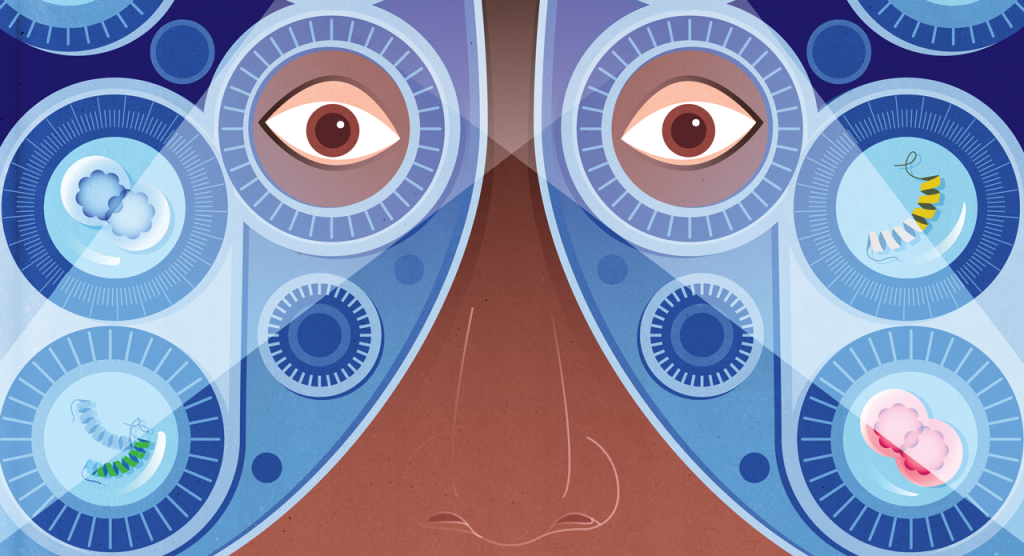By: Juanita Bawagan
19 Jul, 2018

To answer the biggest question, we have to understand the world at the smallest scale
When light hits your eye, hundreds of things happen before you see it. The process starts with a single group of atoms whose presence is responsible for the colour of the retina. They are part of a larger protein that absorbs the light, and as it does, this protein changes shape, bending and binding partners before it sets off a cascade of events that spark an electrical signal transmitted by rod cells to the optical nerve and, finally, to your brain. This all takes place nearly instantaneously, across different scales of space and time.
As colleagues working together at the University of Toronto, Dwayne Miller and Oliver Ernst were interested in the role played in this reaction by a light-sensitive receptor protein called rhodopsin. It triggers nerve stimulation with a 65 per cent quantum yield for every photon of light absorbed. This is one of the most evolutionarily optimized chemical reactions of its kind. And, as Miller and Ernst would later show, this reaction is also one of the fastest chemical reactions known, working at the quantum speed limit, happening in mere quadrillionths of a second.
The two researchers thought that if they could understand the mechanics of rhodopsin, and learn about the design principles in optimization of the protein structure, it would provide clues to unlock countless other biological processes. When they heard about CIFAR’s 2013 Global Call for Ideas, they thought they had the beginnings of a proposal. But they also knew they had to think bigger.
“And so, what’s the biggest idea? Well, we were sort of talking about, ‘What is life?, That’s the biggest single question you could imagine in the field of biology,” recalled Miller. “It was pretty gutsy. I thought we might get shot down, that it was maybe too big.”
Instead, they were chosen to create and co-direct CIFAR’s Molecular Architecture of Life program. Although the questions around the meaning of life are broad and long-standing, Miller and Ernst thought that for the first time science had the tools to address the question directly. Advances in theory and in experimental approaches and especially recent advances in technology meant that science could bring a whole new set of techniques to understanding the very basics of life, right down to an atomic level. Four years into the program, the two researchers think they’ve made a start at answering the biggest question.
Over the course of a few years, Miller and Ernst had watched decades of research converge to answer the basic questions required to understand living systems. The way scientists observed the world had shifted. Before, they could only see life in static states, but now, science was making a jump from molecular photography to molecular movies.

These advances were in no small part due to technological advances. Ultrabright electron sources, a table-top particle accelerator, developed by Miller, and billion-dollar X-ray facilities could light up molecules in motion. Major advances in imaging hold promise to be able to map the chemistry behind such key life-giving processes as molecular self-replication. The challenge to connect all this information is daunting. But with machine learning and increased computing power, the researchers have pointed the way to make the connections between fundamental biochemistry and physics of nonlinear systems to the emergence of life.
Ernst points to the example of cryo-electron microscopy (cryo-EM), whose innovators were recognized with the 2017 Nobel Prize in Chemistry. Cryo-EM freezes molecules to capture three-dimensional snapshots of them in motion. The approach had been in development for more than 30 years, but detector technology and improved computational programs only caught up five years ago, Ernst said.
“I still think the best is yet to come,” said Ernst. For him, atomic resolution of how biological systems work within the living cell is the gold standard.
“If you can look at something that is in motion, you understand how things are related to each other, and this is of course much more complicated. I only hope it will not take another 30 years to get there.”
And so, what’s the biggest idea? Well, we were sort of talking about, ‘What is life?, That’s the biggest single question you could imagine in the field of biology.
When they proposed the Molecular Architecture of Life program, Miller and Ernst hoped to create a program that could grow to the scope of the Human Genome Project. To achieve something on that scale, they had to build a team that would drive both technological development and understanding of the fundamental biology, chemistry and physics that underlie living systems. The Molecular Architecture of Life program includes fellows with backgrounds ranging from physics, chemistry, biochemistry and genetics to basic medicine; they come from Canada, the United States, England, Germany, Switzerland, China and Korea.

“I really look at this as a collection of people with different backgrounds, expertise and knowledge. This heterogeneity makes the system much more powerful because it looks at every problem from a different angle,” said Krzysztof Palczewski, a professor at Case Western Reserve University’s Department of Pharmacology. He is a senior fellow in the Molecular Architecture of Life program and one of its first recruits.
For Palczewski, who is best known for solving the structure of rhodopsin, the answer to life’s greatest questions can be found in the eye.
“The eye is like a window into your brain,” he said.
The eye evolved before the brain and the information it processes is interconnected with the entire nervous system, he explained. The eye is also accessible for existing methodologies and techniques in biochemistry, pharmacology and imaging.
Palczewski has spent his career studying the chemistry and biology of vision, but CIFAR’s program allowed him to examine them in a new way. In a recent paper, Palczewski and Senior Fellow Daniel Figeys at the University of Ottawa revealed multiple signaling pathways involved in phagocytosis, the renewal of photoreceptor cells.
Every day, photoreceptor cells in the retina get replaced as new membranes and proteins are synthesized. We would go blind over time without this process. Scientists have long known that phagocytosis takes place, but there has been little progress in understanding exactly how. Figeys is a specialist in proteomics, a field of biotechnology that looks at the complex connections and data involved with protein networks. By looking at these connections, he and Palczewski are working toward unraveling the molecular basis of this process and others.
p.p1 {margin: 0.0px 0.0px 0.0px 0.0px; text-align: center; line-height: 22.0px; font: 16.0px ‘Circular Std’; color: #2bbbe9}
We’re at a new time in science where we can actually get at this great question everybody asks.
Exploring the pathways within the eye extends to a greater understanding of our bodies as a whole. The eye is home to light-sensitive receptors, which are part of the G protein-coupled receptor (GPCR) family. These receptors act as a “gateway to the cell” and help it to sense its environment. They are also crucial to drug design; approximately half of all medications today target this kind of receptor.
In textbook illustrations, GPCRs look like pool noodles threaded together, or curly ribbons along the membrane of a cell. These ribbons wiggle and bend to send messages and shape when and where hormones bind to specific receptors. But up until the last few decades, scientists had no idea what they looked like or if they existed as a molecule.
CIFAR Advisor Brian Kobilka was jointly awarded the Nobel Prize in Chemistry for his studies in the 1980s that led to the discovery of the GPCR family. In 2011, he would go on to capture the first image of a receptor just as it was activated by a hormone. The Nobel committee described it as “a molecular masterpiece.”

Another paradigm shift in GPCR research came from Senior Fellow Michel Bouvier at the Université de Montréal. Bouvier discovered that many mutations led to disease because of misfolding proteins. Furthermore, he uncovered a way to restore the folding of disease-causing genetically mutated receptors using “pharmacological chaperones.”
“It changed our hope to build new treatment for these diseases, to bring these ‘chaperones’ into the clinic,” Bouvier said. One of the diseases targeted by Bouvier’s group for the development of therapeutic pharmacological chaperone is familial early onset severe obesity.
Bouvier’s studies also led to the concept of GPCR functional selectivity, whereby compounds can selectively regulate subsets of the activities controlled by a given GPCR. This opens the avenue to develop more effective drugs with fewer side effects in many clinical indications.
In the quest to understand life and how it arose, CIFAR fellows are helping to design better drugs, revolutionize technologies and change the way we see ourselves and our world. This hits at the crux of the Molecular Architecture of Life program. Miller and Ernst agree that “seeing is believing” and, most importantly, understanding.
This idea comes across through their research as well as their outreach. Miller is the founder of Science Rendezvous, Canada’s nation-wide science festival. He launched the festival in 2008 to bring science out of the lab and into the streets. Since then, more than 200,000 Canadians, including over 6,000 volunteers, have had hands-on experiences that change how they see science in their everyday lives. To help better explain science using the principle “seeing is believing,” Ernst recently developed the first interactive virtual reality biochemistry lecture with his graduate student. Using special molecule viewers from Autodesk, audience members were able to watch a protein in motion and imagine what life might be like within a cell.
“It is very important for us to reach out of from the science we are doing and make it accessible,” said Ernst. “Then we can illustrate what, for example, is going on in the world at the molecular level … and they can explore it themselves.”

The Molecular Architecture of Life program is already examining the three characteristics that determine whether something is alive — whether it can reproduce, whether it can mutate and whether it is catalytic, or self-balancing. They can be hard questions to answer. They also blend together and the result is more likely a better way to test a question than to provide an answer.
When they do answer “the great question,” it will bring forward many ethical issues. Some are already playing out with artificial intelligence, but a whole new debate would emerge about organisms that could potentially be created independent of another living system.
“We’re at a new time in science where we can actually get at this great question everybody asks and we think, given the fullness of time, we’ll be able to answer what makes a living system,” said Miller.
When asked whether it will be possible to see this within his lifetime, Miller offers a confident “yes.”
“You will get very old,” said Ernst with a smile.
As their laughter settled, they quickly launched into an itemized list of things that need to happen from new technologies and detectors to better physics. It would be enormous to accomplish that in a lifetime, but as Miller and Ernst agree, they don’t even have that kind of time.
“You’ll see in 10, 20 years, somewhere in there,” said Miller. “I think I’ll make it.”